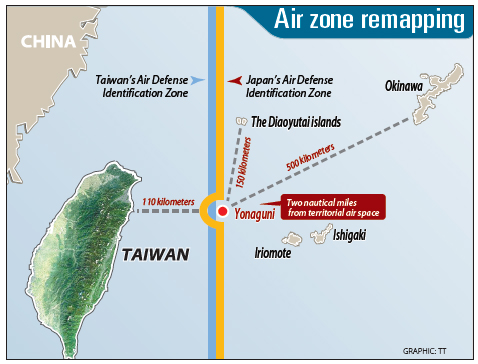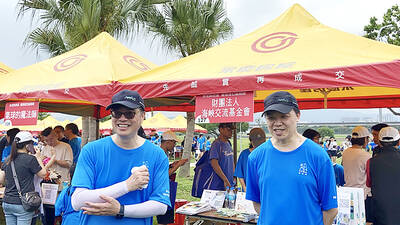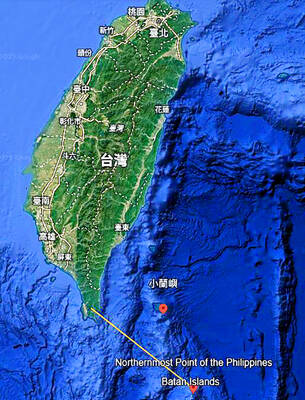Japan has extended its Air Defense Identification Zone (ADIZ) so that it now overlaps with sections of a zone controlled by Taiwan, but foreign affairs officials said yesterday that would not make any difference in practice, as an understanding has been reached between the two parties on how to handle the sensitive matter.
A Ministry of Foreign Affairs (MOFA) official said on condition of anonymity that Tokyo informed Taipei “one or two days ago” that its extension of the ADIZ from Yonaguni Island westwards would come into force yesterday.
An ADIZ is an area of airspace defined by a country within which identification and location of an aircraft is required. Aircraft entering an ADIZ are required to radio their intended course and destination to the country’s air traffic controller, usually both civilian and military.

This was the second time Japan notified Taiwan about the extension plan following a statement by the ministry accusing Tokyo of informing Taipei without consulting it first.
The plan was first reported by the Sankei Shinbum on May 26, five days after the first notification to Taiwan.
The official said Tokyo had no intention of communicating with Taipei on the matter either before the decision was made by the administration of then-Japanese prime minister Yukio Hatoyama, nor after the ministry issued a statement on May 29 expressing “regret” over Japan’s unilateral move.
“Given international norms that ADIZ demarcation is at the discretion of each country, it was natural for Japan not to seek prior approval from Taiwan. However, when there is another country adjacent to the line, consulting with the country in advance is a courtesy,” the official said.
The original ADIZ between Taiwan and Japan runs along longitude 123 degrees east and splits the airspace over Yonaguni Island in half, leaving the area east of the line to Japan and the area west to Taiwan. The line was drawn by the US military after World War II.
The Japanese Ministry of Defense officially announced the new ADIZ line on its Web site on Thursday. Starting yesterday, the ADIZ was extended by 12 nautical miles (22km) from the baseline, with an additional 2 nautical miles as a buffer zone, resulting in an overlap with airspace over which Taiwan holds jurisdiction.
In a telephone interview, Minister of Foreign Affairs Timothy Yang (楊進添) said the government insisted the Taiwan-Japan ADIZ demarcation line “remain unchanged.”
“Each country is entitled to draw its ADIZ. When it comes to overlapping areas, we know how to deal with it. I believe we [Taiwan and Japan] understand each other’s position,” Yang said.
During a meeting at the legislature’s Foreign and National Defense Committee on May 31, Yang agreed to a suggestion by Chinese Nationalist Party (KMT) Legislator Lin Yu-fang (林郁方) that the government ask Japanese aircraft entering Taiwanese airspace in the zone to leave.
Asked by the Taipei Times if this position still held, Yang said “it would depend on the situation.”
“The Ministry of National Defense [MND] is in charge of that issue. However, if, in our judgment, something threatens our airspace, we could have a different reaction,” he said.
MOFA issued a second statement on Thursday night, again expressing “extreme regret” over the rezoning plan and reiterating its opposition to the change.
“There is no possibility the government will make any concession on this issue as it is a matter of national sovereignty,” ministry spokesman Henry Chen (陳銘政) said.
NO PROVOCATIONS
Chen said Taiwan and Japan would not engage in provocations as both sides had made their positions on the matter very clear.
KMT Legislator Liao Wan-ru (廖婉如) said later yesterday that the government should continue requesting negotiations with Japan on the matter.
“The problem isn’t that the ADIZ cannot be redrawn, but rather that Japan should have consulted us instead of making the decision on its own,” Liao said.
Defense ministry spokesman Major General Yu Sy-tue (虞思祖) said yesterday the ministry had a similar position.
Likening the ADIZ issue to the controversial Diaoyutai (釣魚台) Islands, over which Taiwan and Japan claim sovereignty, Chen said both sides would set differences aside and seek acceptable solutions through negotiations.
On reports by Japanese media that the expansion of the ADIZ was part of the Japanese government’s response to a military buildup in China, Yang refused to comment.
CONCERN OVER CHINA
The anonymous official said the rapid growth of the Chinese military in recent years had become a concern for the academic and diplomatic community in Japan.
Democratic Progressive Party Legislator Peng Shao-chin (彭紹瑾) told the Taipei Times last night that Taiwan’s government had to learn how to strike a balance between its relationship with China and with the US-Japan security alliance.
“Japan’s redrawing of the ADIZ suggests that it might not trust Taiwan as much as it used to in light of our government’s moving too close to China,” Peng said.

SECURITY: As China is ‘reshaping’ Hong Kong’s population, Taiwan must raise the eligibility threshold for applications from Hong Kongers, Chiu Chui-cheng said When Hong Kong and Macau citizens apply for residency in Taiwan, it would be under a new category that includes a “national security observation period,” Mainland Affairs Council (MAC) Minister Chiu Chui-cheng (邱垂正) said yesterday. President William Lai (賴清德) on March 13 announced 17 strategies to counter China’s aggression toward Taiwan, including incorporating national security considerations into the review process for residency applications from Hong Kong and Macau citizens. The situation in Hong Kong is constantly changing, Chiu said to media yesterday on the sidelines of the Taipei Technology Run hosted by the Taipei Neihu Technology Park Development Association. With

CARROT AND STICK: While unrelenting in its military threats, China attracted nearly 40,000 Taiwanese to over 400 business events last year Nearly 40,000 Taiwanese last year joined industry events in China, such as conferences and trade fairs, supported by the Chinese government, a study showed yesterday, as Beijing ramps up a charm offensive toward Taipei alongside military pressure. China has long taken a carrot-and-stick approach to Taiwan, threatening it with the prospect of military action while reaching out to those it believes are amenable to Beijing’s point of view. Taiwanese security officials are wary of what they see as Beijing’s influence campaigns to sway public opinion after Taipei and Beijing gradually resumed travel links halted by the COVID-19 pandemic, but the scale of

A US Marine Corps regiment equipped with Naval Strike Missiles (NSM) is set to participate in the upcoming Balikatan 25 exercise in the Luzon Strait, marking the system’s first-ever deployment in the Philippines. US and Philippine officials have separately confirmed that the Navy Marine Expeditionary Ship Interdiction System (NMESIS) — the mobile launch platform for the Naval Strike Missile — would take part in the joint exercise. The missiles are being deployed to “a strategic first island chain chokepoint” in the waters between Taiwan proper and the Philippines, US-based Naval News reported. “The Luzon Strait and Bashi Channel represent a critical access

Pope Francis is be laid to rest on Saturday after lying in state for three days in St Peter’s Basilica, where the faithful are expected to flock to pay their respects to history’s first Latin American pontiff. The cardinals met yesterday in the Vatican’s synod hall to chart the next steps before a conclave begins to choose Francis’ successor, as condolences poured in from around the world. According to current norms, the conclave must begin between May 5 and 10. The cardinals set the funeral for Saturday at 10am in St Peter’s Square, to be celebrated by the dean of the College